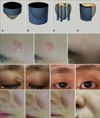Dear Editor:
We read with interest the article entitled "Effective Treatment of Congenital Melanocytic Nevus and Nevus Sebaceous Using the Pinhole Method with the Erbium-Doped Yttrium Aluminium Garnet Laser"1. We have used this method to successfully treat patients with an Er:YAG laser (Action; Lutronic, Goyang, Korea) in continuous-wave mode with a spot size of 1 mm and an output power of 0.2 mJ/cm2 2. We describe here a possible paradigm, a mimetic diagram, and a description of this donut ablation method with an Er:YAG laser.
Fractionated ablation methods can include both space- and pulse duration-fractionation, yielding gentler and safer results. In addition to ablative and non-ablative resurfacing lasers, QS ruby and Nd:Yag lasers have been developed for fractionated methods3. The donut ablation method is a kind of space-fractionated ablation method. This method is an extension of the pinhole method and is based on the fractional photothermolysis theory, which posits that untreated skin is a source of rapid healing and intrinsic cooling of tissue4; however, whereas the pinhole method makes randomly or regularly distributed dot-shaped holes on the lesion, the donut ablation method makes line- or donut-shaped holes, or holes of various shapes, along the rim of the lesion (Fig. 1A~D). Complete removal of the lesion in the treated area requires the hole to be deep enough; that is, the appearance of normal tissue is the endpoint of treatment, resulting in a complete removal in the ablated fraction space. Any erythematous areas remaining after previous treatments were avoided to prevent scarring. Each lesion is treated in multiple sessions, with 1 to 2 month intervals between sessions.
Using this method, we treated 26 patients with various skin lesions. Of these, 16 were almost completely treated, and all 26 showed at least a partial response (Table 1). One 31-year-old female with a nevus sebaceus on her forehead, which was a significant, cosmetically unacceptable size, was treated with this method. After six sessions, the lesion was completely resolved (Fig. 1E~G). A 53-year-old female with bilateral xanthelasma on the medial side of the eyelids was also treated with this method. After three sessions, the lesion was almost clearing without any side effects (Fig. 1H~K). Although xanthelasma can be treated with surgical excision, laser total ablation, chemical cauterization, or cryotherapy, these methods have significant risks of scarring and pigmentary changes after the treatment5. Another patient, a 40-year-old female with a deep dermal melanocytic lesion, was treated with five sessions of Er:YAG laser ablation that produced donut-shaped holes, resulting in almost complete elimination of the pigmented lesion (Fig. 1L~O).
The goal of donut ablation is maximally deep treatments to completely eliminate the lesion; however, the treatment area is confined to multiple dots, holes, lines, or segments to reduce adverse events such as scarring and recurrence. By contrast, the total ablation method utilizes limited penetration depths due to concerns about scarring. If skin lesions do not require removal in a single step, the results may be superior, with far fewer adverse events.
Figures and Tables
 | Fig. 1Schematic diagrams showing (A) a shallow classic ablation, which may leave a remnant lesion, with lesions having a relatively high rate of recurrence; (B) a deep classic ablation, which is associated with an increased risk of scarring; (C) the pinhole method, in which the laser makes randomly or regularly distributed dot-shaped holes on the lesion; and (D) donut ablation, in which the laser makes line- or donut-shaped holes, or holes of various shapes along the rim of the lesion. (E~G) Photographs of a nevus sebaceus in a 31-year-old female (E) before treatment, (F) one month after three treatment sessions, and (G) one year after the final treatment (six sessions). (H~K) Photographs of a 53-year-old female with xanthelasma on both medial sides of the upper eyelids. (H) Right and (I) left sides before pretreatment. (J) Right and (K) left sides three months after the last of three treatment sessions. (L~O) Photographs of a 40-year-old female with dermal melanosis. (L) Before treatment; (M) generation of a deep donut-shaped hole to remove deep-seated cells; (N) generation of another donut-shaped hole one month after the first session, while avoiding previously treated erythematous areas; and (O) three months after the final treatment (five sessions). |
References
1. Chung BY, Han SS, Kim BW, Chang SE, Lee MW. Effective treatment of congenital melanocytic nevus and nevus sebaceous using the pinhole method with the erbium-doped yttrium aluminium garnet laser. Ann Dermatol. 2014; 26:651–653.

2. Lee HM, Haw S, Kim JE, Won CH, Lee MW, Choi JH, et al. A fractional 2940 nm short-pulsed, erbium-doped yttrium aluminium garnet laser is effective and minimally invasive for the treatment of photodamaged skin in Asians. J Cosmet Laser Ther. 2012; 14:253–259.

3. Kim BW, Lee MH, Chang SE, Yun WJ, Won CH, Lee MW, et al. Clinical efficacy of the dual-pulsed Q-switched neodymium: yttrium-aluminum-garnet laser: comparison with conservative mode. J Cosmet Laser Ther. 2013; 15:340–341.





 PDF
PDF ePub
ePub Citation
Citation Print
Print



 XML Download
XML Download